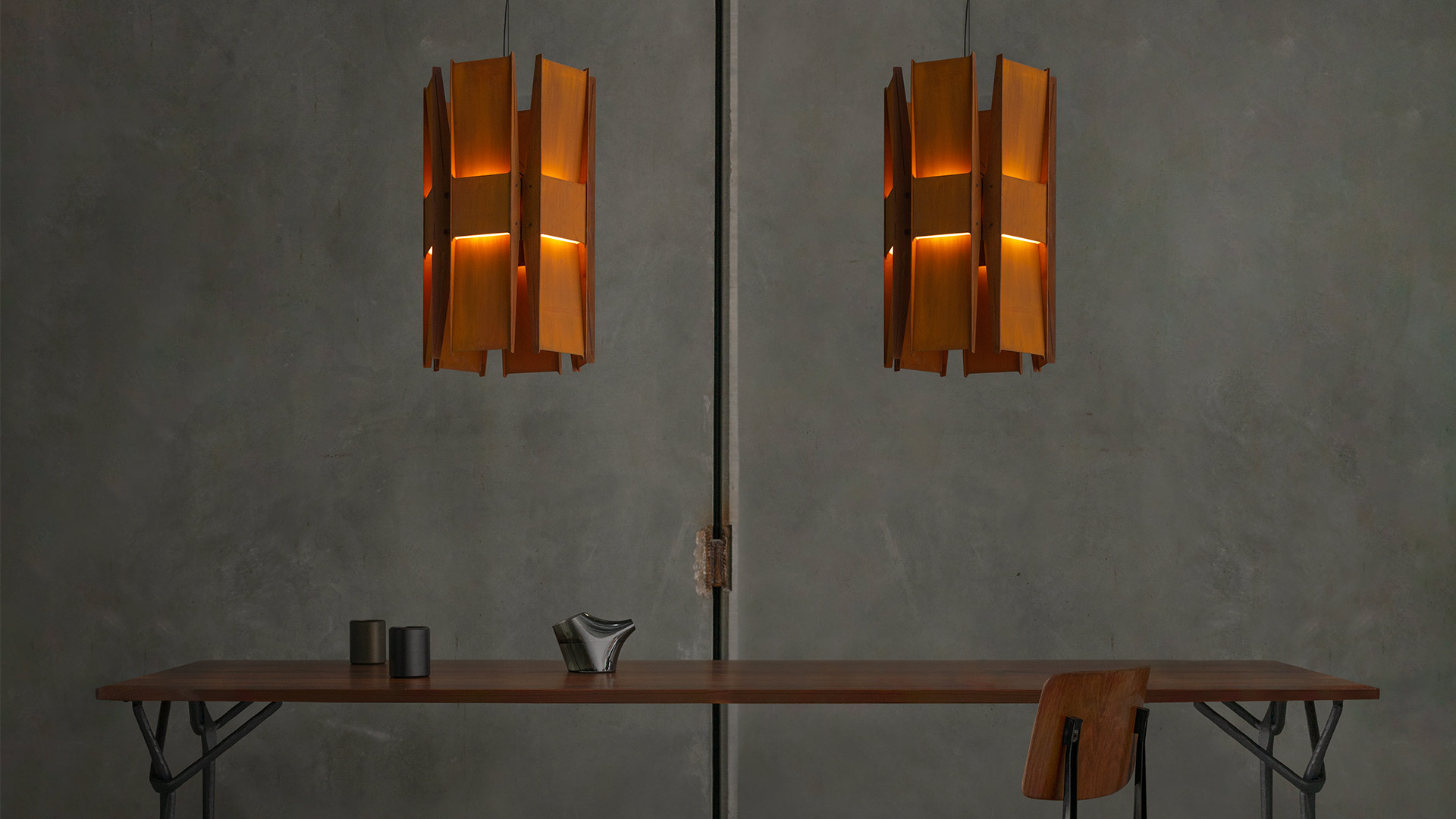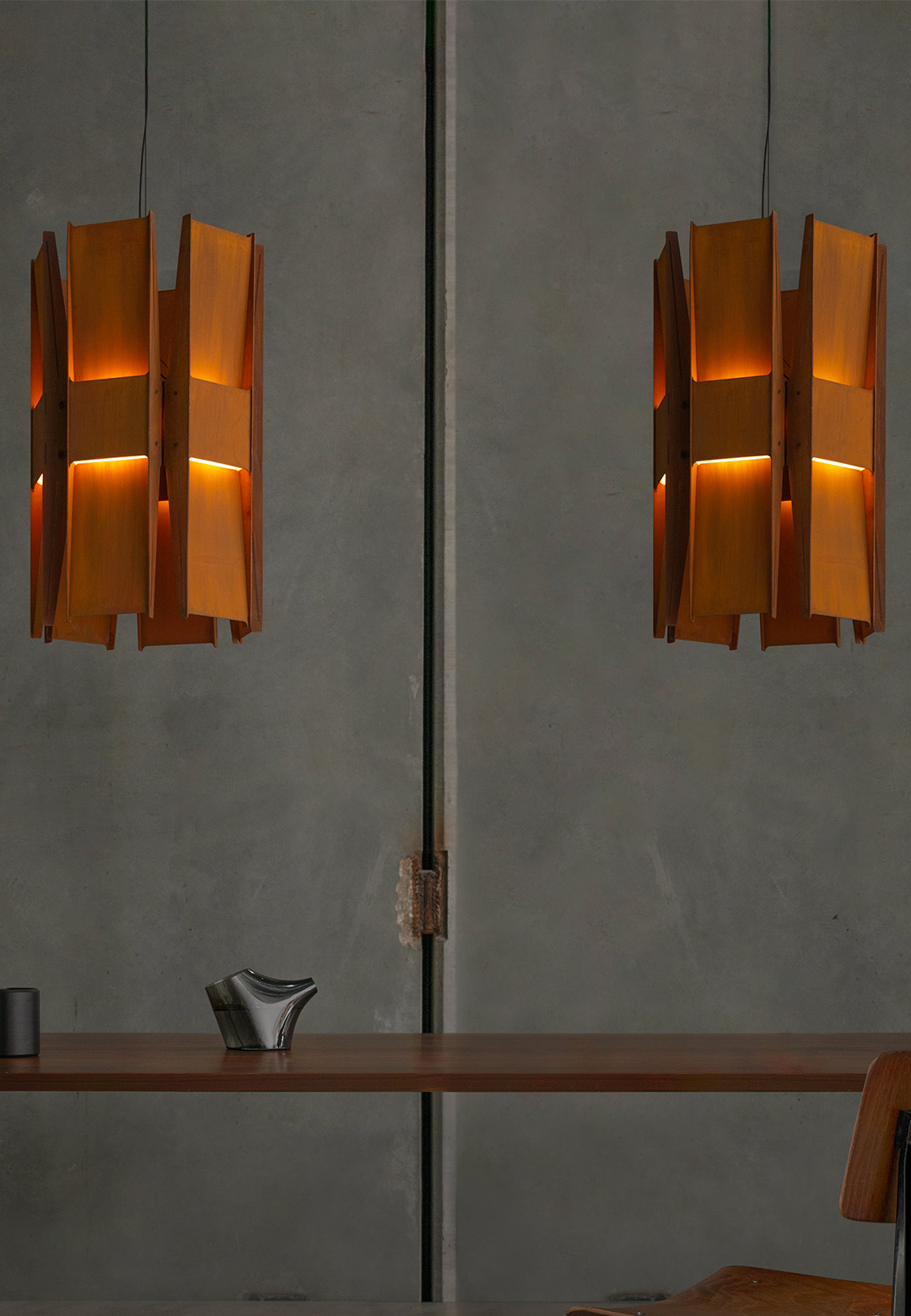Lukas Peet, co-founder of Canadian lighting brand A-N-D and founder of Lukas/Peet Design has conceived a Brutalism-inspired luminaire collection redolently titled Vector—the comprising lamp designs for A-N-D are cut from ‘precise paths’—what graphic designers refer to as vectors, endowing the series its name. “In reverence of great Brutalist monuments, the luminaire reveals slight openings on architectural planes as it plays with voids and volumes. Showing a simple and understandable form, it also emphasises bold and strong materiality; its raw finish bares its honest and natural state,” the lighting designer elaborates.
The conceptual essence of the lighting design collection found its genesis in an exploration into various sheet materials, as well as an inquiry into whether the finish of the fixture could be determined by the raw, natural materials, instead of the more traditional application of a finish to an employed one, that is, painting, metal plating, anodising or allied surface treatments. “I will continue this exploration with other materials as the design of the fixture can be cut from any sheet material,” Peet shares.
‘Raw, precise, slender, and honest,’ the Vector luminaire collection currently comprises two pendant fixtures (pendant 3 and pendant 6) as well as a table, floor, and sconce version, articulated in three subtle materials alluding to the severe industrial rawness of Brutalism: weathered steel, black steel, or polished stainless steel. “I find the rawness, materiality, and reduced forms of Brutalist architecture interesting in this context. With Vector, I was also exploring these elements and how they could be translated to a light fixture as well as a much smaller scale, while keeping the essence of the inspiring Brutalist elements,” he remarks.
Several plane panels are fitted together to create slender rectilinear sections known as the ‘vector,’ directing light to wash down the inner sloped surfaces of the lighting designs, proffering an attractive gradient effect. According to Peet, each fixture of the contemporary design collection is cut precisely from various sheet materials while maintaining a tolerance of 0.1mm. With an industrial aesthetic, the designs are derived from 2mm sheets, flat and thin, to ensure that proportions remain slim once assembled. “It is honest, as the finish bares the actual material, not an applied layer or treatment, bringing attention to it as well as its imperfections that celebrate its unique and natural textures,” he relays.
Subsequently, the rawness of the employed material became one of the primary inspirations for Vector—“I wanted to bring awareness and admiration to the beauty of these materials. With natural wood or stone, no two pieces are the same, and their distinct grain structures are celebrated and accepted. Regarding metals, the expectation tends to be towards perfection and uniformity or to be covered in a specific aesthetic finish. My approach to the fixture's design was purely functional, using simple shapes to direct the light. These planes also create a defined constraint of the material, allowing the uniqueness of the finish to be understood and admired, much like the framing of a painting or photograph. The crop constraint allows for the subject to be comprehended,” Peet shares.
The pendant version features three or six rectilinear sections in vertical alignment which are elevated by aircraft cables connected to a hub at the fixture’s centre. While suspended, the light from the ‘Vector Pendant’ pours into its hollow centre, proceeding to fill into the inner and outer faces in a bi-directional manner. Venerating and referencing Brutalist architecture, the ‘Vector Ceiling/ Wall,’ the ‘Vector Table’ lamp, as well as the ‘Vector Floor’ lamps reveal slight openings on ‘architectural planes,’ as they indulge in an intended play of voids and volumes. In the former, a solo rectilinear section can be fixed to the wall in both, vertical and horizontal configurations, divulging the luminaire’s ‘honest, reductionist’ profile. The table lamp and floor lamp variants adjoin three rectilinear sections vertically, to illuminate its inner and outer surfaces bifacially, ‘affirming stillness in its statuesque beauty.’
According to the product designer, this collection’s moniker was chosen for binate reasons—"First, the definition of the word 'vector' is put most simply as, '...having direction, especially as determining the position of one point in space relative to another.' This was portrayed in the design of the fixture by directing the light to wash both up and down its sloped surfaces, from the central point of the fixture and outwards. Secondly, the 2D design file that is used to either laser cut or water jet cut, is actually called a 'vector file'. The design of the fixture is composed of 2D shapes and then constructed to be a 3D object,” he explains.
For the initial prototyping, cardboard and paper were employed, where simple rectilinear shapes were used to construct volumes. A light source was added further, to understand how each plane could shape and direct light. “The next steps were to reduce the planes to leave only what was essential, then refine them to have subtle decorative elements and finalise how they intersect and relate to one another,” the designer shares. When this base design was complete, various materials were investigated for their aesthetic qualities and studied thoroughly for how they interacted with light. “Lastly, we designed each element to work cohesively with one another, taking into consideration how the fixture would be produced, assembled, installed, and function consistently without detracting from the essence of the design,” says Peet, highlighting the creative process that led to the Vector series manufactured in Canada.
“In my practice, I enjoy a wide range of creative disciplines,” shares Peet, who is active in the fields of graphic design, product design, public space, as well as interior design. “I enjoy how these differing mediums, scales and functions push my process. I prefer not to be limited to a certain discipline and find connections between the various works all the time. My spatial projects have greatly influenced my understanding of my luminaire designs as well as my understanding of the needs, uses, and functions of light in an environment—How the environment is influenced by the light but also how the greater environment of the space (location, climate) influences the space and therefore, the needs and functions of the lights,” the Canadian designer relays.
The cornerstone of the designer’s creative ethos is grounded in function, materials, scales, as well as production techniques and craftsmanship. “A design is complete in my eyes once I have explored each of these elements and they work in relation to each other in balance. The goal for me is to create an object that considers the above in a refined, pure and honest matter,” Peet relays. “With A-N-D, I am currently working on new collections for 2025 and new additions to ongoing collections for 2024. With my own studio, I am presently exploring new materials and processes in very open research—with the goal of a new limited-production collection in the near future,” he concludes.






 Sign in with email
Sign in with email








What do you think?